
Electronic english version since 2022 |
The newspaper was founded in November 1957
| |
|
Number 23 (4721) |
Jubilees
Physicist and Time
13 June marked the 90th anniversary of the birth of the chief researcher of the Laboratory of High Energy Physics Professor Vladimir A.NIKITIN. His entire bright scientific biography is united to JINR, where he initiated and participated in research widely recognized in the world physics community.
JINR Directorate, VBLHEP Directorate, friends, colleagues and students heartily congratulate Vladimir Alekseevich on his anniversary, wish him new achievements in scientific activity, happiness and well-being.
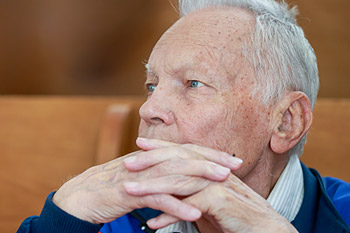
Everything begins at school
Aristotle said that knowledge begins with wonder. But primary school student Volodya Nikitin had no interest in studying. He was bored during lessons, looked out the window, where the world of his interests stretched out - in short, he was in the clouds. No one was surprised when he was held back for a second year in the fourth grade. The teacher said to his mother: "Well, what can we do, Lida..." His mother was a teacher herself. But she did not have any harsh conversations with her son.
He was not held back for a third year - it was not practiced in the Soviet Union. And in the fifth grade, a miracle happened. At the beginning of the first quarter, a new German teacher, a former front-line soldier, came to school. He possessed the most important pedagogical quality: patience. He worked with the difficult student after classes. And so, little by little, he inspired in the student a craving for book knowledge. Before the first quarter had even ended, one fine day, the German texts came to life for the boy! "I became interested in studying!" Professor V. A. Nikitin exclaimed triumphantly, finishing this instructive story from his childhood. On vacation, he brought home... No, you won't believe it. His parents didn't believe it right away either. Without looking at the diary, his father grabbed his belt out of habit... But he still opened the diary. There were only A's in it!
The young man was not afraid of difficulties. He took one summit after another. He graduated from school with honors. He entered Moscow University. He defended his diploma thesis at the accelerator department and in 1958, he was assigned to Dubna. And 12 years later, he defended his candidate's thesis that was considered as a doctoral thesis.
The history of a method and two discoveries
Dmitry Ivanovich Blokhintsev, the first director of the United Institute, once noted that before the eyes of his generation, physics had turned from a vocation into a profession. But in the late 1950s, physics was still surrounded by a romantic halo...
It was 1955, the 25th year of the accelerator era. Another "atomic giant" was being constructed in Dubna, in the High Energy Laboratory. Its appearance was astounding: two or three stories high, 150 meters in perimeter - an impressive achievement of physics, radio engineering and precision mechanics.
When a locomotive pushed a platform loaded with electromagnet blocks into the synchrophasotron pavilion, this spectacle attracted the attention of a fourth-year student of the Physics Department of Moscow State University, brought with his comrades on an excursion. The student watched without stopping as the crane picked up block after block and carefully placed them on the concrete base. The student even looked into the vacuum chamber. He saw nothing there except empty space: there were no particles rushing at near-light speed under the control of the magnetic field, nor the field itself. But the feeling that he had looked into the world of elementary particles remained. He was called and he went on, excited, full of anticipation of future achievements of science and technology and his participation in them... This is approximately how Vladimir Alekseevich Nikitin, chief researcher at the Laboratory of High Energy Physics, later recalled his first visit to Dubna.
There were 12 of them, graduates of the Physics Department of Moscow State University in 1958, most of them from the accelerator department. You could say that it was the "Veksler call". Some settled in the High Energy Laboratory, some went to the Neutron Physics Laboratory and some eventually moved to Serpukhov, where in 1967, the largest proton accelerator of that time was launched.
Nikitin stayed. The laboratory was having fun! Everyone was young, the laboratory itself was still very young and even the director, a man of an older generation, a great scientist, felt young. After the synchrophasotron started operating, delegations walked around the laboratory in crowds, as if around VDNKh. The atomic giant was operating at full speed, physicists and laboratory assistants were sitting at microscopes, studying events on photoemulsion plates and "relativistic engineers" were struggling with the problem: how to increase the beam intensity at least 1000 times?
Student Nikitin did not get lost among this crowd of people. He was given a supervisor and he felt that science was nearby. The age difference with the supervisor was small, but Nikitin continued to call the young engineer-physicist Viktor Sviridov, a graduate of the Leningrad Polytechnic, supervisor even many years later. The story of one method and two discoveries began with Sviridov - a method that went through all the laboratories of the world where high energy physics was studied.
Studying the course of a beam in an accelerator, Sviridov noticed that protons that had "stumbled" after passing through a thin target "returned to the ranks" on the next turn of the beam - in other words, he saw the principle of autophasing that he actually knew about from a special course at the university. It gave him the idea that it was possible to pass a beam through a target many times and the statistics would increase by the same amount. It dawned on him when the evening twilight outside the window thickened into the darkness of night and the god of dreams Ole Lukkoye opened his magic umbrella over the High Energy Laboratory.
In the method that was developed based on this idea, instead of one target, as is usually the case, two are used. The first is the target itself, the second plays the role of a register of the recoil particles flying out of the first. The beam does not damage the second target (it is off to the side) and the first does not damage the beam. The beam passes through the target tens of thousands of times. The statistics increase by the same amount! The idea turned out to be so simple that… "At first, they didn't even want to hear about it. Then they began to lean towards the idea that "there is something in this". When everything worked out, the idea began to seem obvious."
But before starting to develop the method and there were many technical difficulties to overcome, it was necessary to enlist the support of the directorate. That is, the director of the laboratory. That is, Vladimir Iosifovich Veksler. The young people went to him not without apprehension, knowing from experience that a test more serious than any exam was ahead. Vladimir Iosifovich was a peculiar teacher, reminding one of Her Majesty History that according to Klyuchevsky, teaches nothing, but only sternly asks for an unlearned lesson. The first reaction could be: what nonsense? And then the innermost thoughts, set out on paper, would fly into the trash. Nikitin once observed such a picture with his own eyes. People with a weak nervous system did not come to Veksler after that. And those who were stronger, took out the crumpled sheets, straightened them out and the next day, as if nothing had happened, showed up with a new version. Have you thought about it? Have you thought about it? Then let's get down to the matter... Here, Veksler would quickly get excited - "he was an excellent debater!" - and the paper lump would fly into the bin again. And the third time, the wonderful phrase would sound: "Why didn't you tell me this right away?" But it also happened that the verdict would follow: "I forbid you to do this!" And this could no longer be appealed.
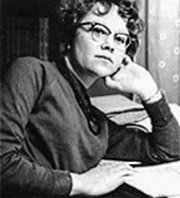 |
| Maria Georgievna Shafranova |
Newspapers wrote a lot about victories in Soviet physics and there were victories and the main one was the antisigma-minus-hyperon (antiparticles were still a novelty at the time), discovered by a large international team of researchers in 1960. And Vladimir Alekseevich still had two and a half years left before the discovery. And Maria Georgievna too and Sviridov, of course and three more future co-authors, because only theoreticians can make discoveries alone and not always.
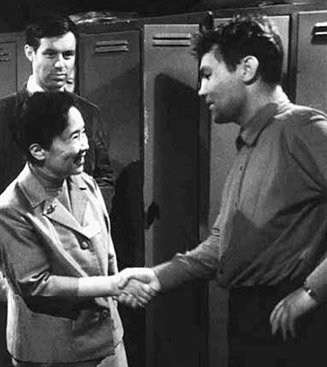 |
| Young physicist Vladimir Nikitin is shaking hands with the famous Mrs.Wu |
Here is one of those little things: the door swung open and Maria Georgievna saw next to Veksler… Niels Bohr!
While the great Bohr was making his way through the labyrinths of the High Energy Laboratory, Sviridov was sitting inside the pi-meson channel, helping his colleague Strunov to build a radiation shield from lead bricks. Physics is not a temple, but a workshop and a man is a worker in it, Evgeny Bazarov would say here and Sviridov was of the same opinion. To the call: "Guys, Bohr!" he responded not too respectfully: "All sorts of Bors are walking around here." But he still got out. Before him, stood a classic of modern natural science. Sviridov was thirty, Bohr was almost eighty. Physicists of two generations looked at each other with interest.
"These are our youth," Veksler introduced the young man to the patriarch of quantum physics.
Bohr extended his hand first. The handshake took place. Through one person, Sviridov shook hands with a great many great people of the world...
By 1962, the thin internal target method was implemented in working equipment. There was no question about what to measure. Everyone was still under the impression of Hofstadter's experiments that discovered the electromagnetic structure of the proton at the electron accelerator in Stanford. But the nuclear structure of the proton was unknown and it opened up scope for research.
Six months later, the results were confirmed at accelerators in Geneva and Brookhaven. What next? Obviously, it was time to sit down to write dissertations! Maria Georgievna did just that. And Vladimir Nikitin had no time for this, he was carried away by a new idea: to measure a polyethylene target with a supersonic hydrogen jet. The idea was suggested by the head of the department K.D.Tolstov and was implemented, in alphabetical order, by L.S.Zolin, V.A.Nikitin and Yu.K.Pilipenko. It was a risky step. It meant depressurization of the accelerator. The Dubna synchrophasotron was not suitable here, an accelerator with rigid focusing was needed. Such an accelerator was in Serpukhov: 70 GeV, one and a half kilometers in perimeter - another giant in the accelerator population.
It was a collective effort to prepare for the experiment: the design bureau, the chief power engineer's department, the transport department, the vacuum group, the cryogenic department - everyone worked to prepare for the Serpukhov experiment. The target was deverloped by Yu. K. Pilipenko's group. The key question: how to ensure rapid pumping of hydrogen injected into the vacuum chamber? They started from scratch. They worked out possible solutions. Gradually, the design emerged...
When everything was ready, the question arose: how to transport it? Disassemble it and then set it up again on site? It would be a waste of time. They came up with a brilliantly simple solution: let's transport it like this! They found a bus, took everything out of the cabin and placed the equipment in it. The bus safely reached Serpukhov (or rather, Protvino), drove into the measuring pavilion, all that was left was to connect the cables and the equipment started working!
It was one of the first online experiments in the USSR. The data were immediately fed to BESM-3M: the session would start in the evening and the processed results would be ready in the morning.
Nikitin's group saddled the Serpukhov synchrotron. Task No.1 was to refute or confirm what the theory predicted at high energies. Result: about 10 million events of elastic scattering of protons on protons were registered. Angular distributions in the diffraction region were constructed. The "meson coat" of the proton that was talked about so much at the time, turned out to be inseparable from the proton itself, its structural component: if the proton threw off its "coat", there would be nothing left of it. Physicists all over the world were eagerly awaiting the publication of the results. Write, no need for translation! As Vladimir Nikitin said then, "We are going through a dramatic stage in the understanding of nature." How many such dramatic stages there have been! But this stage was special. From the vantage point of the past years, it is not difficult to understand. Physics was approaching the experimental discovery of quarks. It looked like an invitation to a scientific revolution...
And again the theoreticians' predictions were refuted. And again a discovery. The bus with the equipment returned home, ready for new experiments. A year later, at a conference on high energy physics, Nikitin's appearance on the podium was met with a round of applause and the results obtained at the Serpukhov accelerator became one of the "highlights" of the programme - it was a small triumph that was written about in the institute's newspaper.
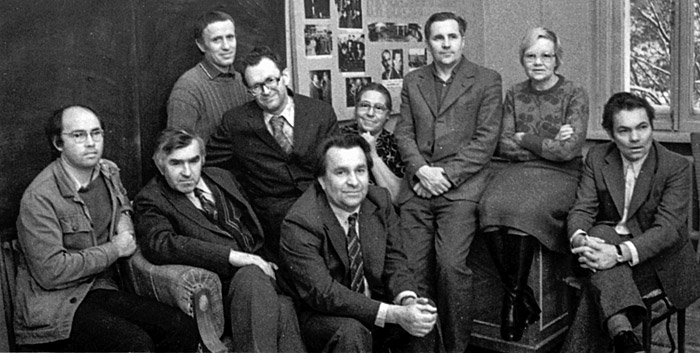
Co-authors of two discoveries, from left to right: P.V.Nomokonov, V.A.Sviridov, N.K.Zhidkov, A.A.Nomofilov,
L.N.Strunov, L.F.Kirillova, L.S.Zolin, M.G.Shafranova, V.A.Nikitin. 1981. Photo by Yury Tumanov
Meanwhile, the supersonic gas target method continued its triumphant march around the world. In 1972, Batavia fell. There, at the National Nuclear Centre, another atomic giant was put into operation, at 200 GeV - high energy physics continued to move forward. The international situation was favorable: another warming in Soviet-American relations was outlined.
Together with the method, its authors went to the USA. Nikitin headed the group. Having reached Batavia, Vladimir Alekseevich learned that the Programme Committee had rejected the Dubna project as too risky. Director of the laboratory, Robert Wilson, apologized: they had not had time to warn him. However, what happened next was what in Marxism is called the role of personality in history - during the conversation, the issue was decided in favor of the Dubna experiment.
Vladimir Alekseevich is a delicate person, you will not hear the word "no" from him, but when it comes to principles, few can resist the force of his convictions. Upon entering, he immediately took the advice of the secretary to pay attention to the multi-colored cubes of the panel hanging on the wall. If the cubes were turned with the red side, the secretary warned, the issue would be resolved positively and if with the black side, then the boss had no good news for you. All the cubes were turned with the black side and Nikitin decisively changed them to red. Wilson smiled. He thought: there is something in this Russian. I must give him a chance... The conversation was over and Nikitin was about to leave, when Wilson suddenly asked: what is that in your briefcase? There was a stack of photographs of Yury Tumanov taken at the LHE. Something about them interested Wilson. He began to examine them carefully. Seeing Russians in earflaps in one of the pictures, he was amazed: and you work in such a temperature? And after a pause, he decisively declared, "We will do this experiment!"
The Dubna group worked in Batavia for a year and a half and this experiment marked the beginning of work on the new American accelerator. An extraordinary event for those times, the joint contribution of Dubna and Batavia to the relaxation of international relations. But Maria Georgievna was not allowed to go to America. The officials from the State Committee for Atomic Energy could not be convinced. They reminded, "Your husband is now in Geneva." Maria Georgievna objected "I know that he is in Geneva, so what? He is not there just like that, he is on a scientific mission! And I am not going there to rest." Vladimir Alekseevich said, "I will not go without Shafranova." But Maria Georgievna persuaded him and he went.
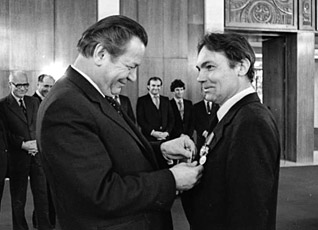 |
| Ambassador Extraordinary and Plenipotentiary of Bulgaria Dimitar Zhulev is awarding the Order of Cyril and Methodius, 1st degree, to Professor V.A.Nikitin. 1982. Photo by Yury Tumanov |
Vladimir Alekseevich wrote his memoirs "The first turns of the beam". Maria Georgievna prepared a biographical reference book of JINR. Why did they stay away from the discovery of quarks? The method is not designed for this. It is applicable for small scattering angles and quarks were discovered during backscattering. By the way, in the same Stanford and also on an electron accelerator, only 10 times more powerful. We did not have such accelerators. Bruno Pontecorvo once noted that if high energy physics in the Soviet Union had not stopped at the level of the 1960s, the Cold War would not have been lost.
The story of one method and two discoveries is coming to an end. We will finish it with Vladimir Alekseevich's story about how he visited Fermilab again in the first half of the 2000s. He saw the same 15-story building of an unusual shape, designed by the first director Robert Wilson, an architect by his second specialty and the same winter garden was at its base. He saw the same nesting dolls with familiar faces. They were painted from our wives! Yes, yes, Professor Nikitin, we certainly know you! And what are you doing here? Well, I want to suggest continuing the investigation of particle diffraction… How? Aren't you looking for the Higgs boson? No, not at all. Then you have nothing to do here!
On the benefits of teaching and scientific reflection
In the early 1990s, with 35 years of scientific work behind him, Vladimir Alekseevich came to the conclusion that the work of a physicist, at least an experimenter, is deterministic; he can judge it without reference to someone else's life experience; he acts according to instructions. But what about the joy of learning? He had it in his life: "And only sometimes does he experience the joy of creativity..." He had the joy of recognition in his life and more than once: two diplomas for a discovery, the USSR State Prize in 1983...
Vladimir Alekseevich says that he learned a lot from Veksler. But he did not follow his call: "Don't be amateurs, trying to know everything, strive to become academicians in your specialty!" And although he achieved the level of an academician in his field (and the Academy of Sciences should have paid attention to this), yet, unlike Gogol's Korobochka, he never locked himself "in the shell of his small farm".
He had always been interested in the philosophical tasks of physics. For many years, he taught a methodological seminar. By lecturing to students (his professorial title obliges him to do so), he broadened his horizons and thereby, avoided the fate of his colleagues, the industry physicists, because he followed the imperative of Richard Feynman that said: if you, a quantum physicist, are not able to explain to a five-year-old in a few words what you do, then you yourself do not really understand it.
Students for a lecturer are not only an "outlet", they are an elixir of eternal youth and creative inspiration. To infect young people with a thirst for knowledge and receive a powerful surge of creative energy in return. Together with them, to rediscover the world. Students require time and attention, but even indoor flowers require attention and they are worth it.
In 1986, at the school for young scientists in Kletinsky Bor, Vladimir Alekseevich, giving a lecture on the current state of elementary particle physics, began by saying that over the past 10-15 years, the terminology has completely changed: if someone had gone to the North Pole for this time and then returned, he would not have understood what his colleagues were talking about. We all believe in quarks now, Vladimir Alekseevich summed up triumphantly, lightly touched on Dirac's monopoles and moved on to strings... He lit up the audience, lit up himself from it, at some point he spread his arms, as if stretching a gluon string - that's when Yury Tumanov, our master of photo portraits, snapped a picture of him...
But the revolution that physicists dreamed of in the 1960s of the last century never happened. The very name of the modern particle theory: the Standard Model - speaks for itself. Well, quarks. Well, strings. And nothing like the breakdown of the worldview that quantum mechanics brought with it. The same Lagrangian formalism and the principle of least action. The same wave function and its probabilistic interpretation. The same Heisenberg uncertainty relation. The same space-time in the microworld and no discreteness.
Another 10 years passed. The work of the experimenter was reduced to the simple art of measuring and adjusting experimental data to theoretical prototypes. Unfulfilled expectations of another scientific revolution were replaced by dreams of a "new physics". In an article written for the 40th anniversary of JINR, Vladimir Alekseevich summed up the development of physics in the second half of the 20th century: "In the field of accelerator technology, reality has surpassed all the boldest assumptions... In the field of experimental technology, reality also turned out to be richer than fantasy... Technologies developed for high energy physics have found wide application in related fields of science and practice... A deeper level of the structure of matter has been discovered."
The revolution that was talked about in the late 1950s and the first half of the 1960s really happened, the author summed up, but: "Its direct consequences are very modest... Our knowledge of the nature of things remains within the walls of our laboratories." And he added hopefully: maybe the time has not come yet?
In search of meaning
People are born philosophers, just like poets, but much less often.
Arthur Schopenhauer
Joint conferences of Moscow philosophers and Dubna physicists were initiated in 1966 by the first director of JINR D.I.Blokhintsev and theologians and priests were brought in by his scientific grandson V.N.Pervushin in the early 1990s. He, V. A. Nikitin and professor of the Moscow Theological Academy A.I.Osipov became the backbone of the conferences "Science. Philosophy. Religion". There was plenty of skepticism. What can physicists talk about with theologians? They hadn't even been able to agree with philosophers for so many years. Father Lavrenty responded to the invitation with the remark: "Swan, crayfish, pike".
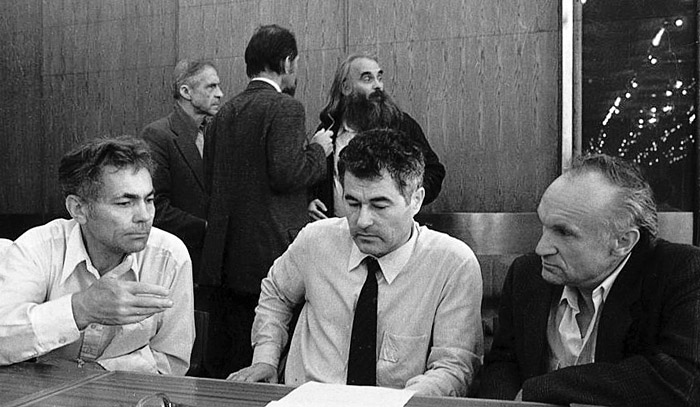
V.A.Nikitin, V.N.Pervushin, A.I.Osipov. 1992. Photo by Yury Tumanov
And yet, the need for communication turned out to be stronger: in 2016, physicists and theologians met for the nineteenth time. Alexey Osipov represented theology all these years, Viktor Pervushin was in no man's land, between science and religion and Vladimir Alekseevich (at least, at first) spoke from the position of an experimental physicist, extracting, as Rutherford said, the hard facts of nature. Like Galileo's Simplicio, he was not afraid to ask simple questions. He did not always receive answers to them and even more rarely, did these answers satisfy him. If God exists, why doesn't He come to our conference? We could film Him to show other people. Or, even better, why doesn't He speak at the UN? If we are God's children, why doesn't He appear to us himself, without intermediaries?
And only once did he hear an answer that, as a physicist, completely satisfied him. Professor of Theology A.I.Osipov asked: "Have you met Electron? For example, I have never met this subject, although the adherents of a strange religion called "Physics" claim that it supposedly exists even in me. But I am not such a simpleton as to believe in these fairy tales! And quarks? What do you say about them? Now, there are also some strings!" The answer was accepted.
Anomalous lepton
Happy is the man that sees in the work of today a reasonable part of the work of his whole life and the embodiment of the work of Eternity.
J.C.Maxwell
The Creator, whose plan remained unsolved for Vladimir Alekseevich for a long time, gave him creative longevity. Several years ago, Vladimir Alekseevich returned to the problem that worried physicists of the 1960s of the last century - the problem of the mass spectrum. The famous Gell-Mann showed how to organize this entire "zoo" of elementary particles, but neither he nor other creators of the modern physical picture of the world were able to build a theory in which the masses of particles would be calculated from it itself and not "introduced by hand". Is this really an imperfection of nature itself (read - the Creator)? Vladimir Alekseevich could not believe it. In nature, everything should be expedient. the great Leibniz said so.
Once, Vladimir Alekseevich was lucky: he caught something that had previously escaped the attention of his colleagues in the shop. Something prompted him to number the leptons in order of increasing mass: in the refined language of science, he gave them quantum numbers and plotted their masses on a semi-logarithmic graph. He did not bother with the semi-mythical quarks and focused on the leptons, whose form of existence is much more accessible to our understanding. And then, as Vladimir Alekseevich himself says, he was inspired by the example of Mendeleev. Dmitry Ivanovich bequeathed: "Do not be afraid to leave empty cells - it means that there is an object that has not yet been discovered." And after Vladimir Alekseevich left one empty position on the abscissa axis, between the electron and the muon, all the masses, differing by 12 orders of magnitude, lay on a straight line, as expected!
This is how the very "anomalous" lepton was born. This is, of course, just a reconstruction. How the idea was actually born, no one will say now, including Vladimir Alekseevich himself. The principle of complementarity worked here, the scope of applicability of which is by no means limited to quantum mechanics: in psychology it has long been noted that it is impossible to think and follow the course of your thoughts at the same time. But we know for sure what was not there at the birth of this fruitful idea. There was no Newton's apple, no Archimedes' bathtub, no Mendeleev's sleep. And we know exactly what happened next: "... I ran to LIT, where on the sixth floor there were still large viewing tables and a working stereo magnifying glass. The girls found me 30-year-old films from a propane camera..."
Returning to 20th century physics, he saw it, this not yet discovered object. Having calculated the mass of one of the particles that left a trace on the next picture, he came to the conclusion that the first confirmation of his hypothesis had been obtained: this was exactly the mass of the unknown lepton, which he allocated an additional position between the electron and the muon to.
Six months later, Vladimir Alekseevich already had nine events that confirmed his hypothesis. And yet, he was in no hurry to draw conclusions. As Jules Renard said, a scientist is a person who is almost certain of something. Another six months passed before Vladimir Alekseevich decided to come out with his ideas to a general laboratory seminar.
As he had predicted, the news of yet another lepton that no one had ever seen before, did not inspire enthusiasm. Theorists immediately declared that there was no room for another lepton in the theory. Frankly, the argument was so-so. As Joliot-Curie said, the further from theory, the closer to the Nobel Prize. And what did the experimenters say? Having seen a lot in their lifetime, they were not so categorical, but no less skeptical. You never know what you can "see" in the pictures, a lot depends on the interpretation. Then tell me where, in what way am I wrong? - the author asked. The question hung in the air...
It did not stop Vladimir Alekseevich. Veksler's school had not passed without a trace for him. The author of the anomalous lepton continued to work, multiplying the evidence and this year, his article finally saw the light of day: it was published in the electronic scientific journal arXiv.org. Could the author have been given a better gift for his next anniversary?
Happy birthday, Vladimir Alekseevich! We wish you creative success!
Alexander RASTORGUEV